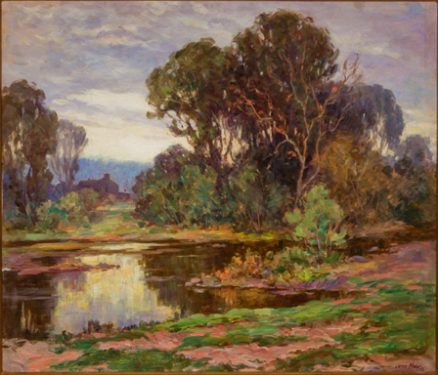- Categories
- Landscapes
- Zoom in on Artwork
- Print Page
- Email Page to Friend
Jess Hobby’s Summer Landscape presents a quiet rural scene dominated by clusters of trees near a shallow pond or stream, its surface reflecting the bright but overcast sky. The tallest trees are rich with full summertime foliage, but set against them are others already marked by the change to autumn. In the distance, what appear to be farm buildings are reduced to silhouettes against the fading daylight, furthering the impression of an elegiac end-of-season mood. Eschewing detail, Hobby used broad, rapid strokes of paint and nervous, active line to enliven this image of a peaceful, deserted spot.
As an experienced professional scenic painter, Hobby was well-versed in techniques for economically conveying a setting on a life-size scale to transport theatergoers to imagined places. His easel landscape paintings reflect a similar ability to capture a scene not through visual detail as much as the evocation of light conditions and time of day, particularly by means of color and the expressive manipulation of paint. By the 1930s Hobby’s approach to landscape painting—his focus on contemplative mood and on nature rather than social themes—was a thoroughly conservative one that struck a chord with a mainstream public. In 1933 he won a popularity prize in the annual exhibition of the Austin, Oak Park, and River Forest Art League (now the Oak Park Art League). The artist himself insisted that he was a “radical” for his refusal to follow artistic fashion, aiming instead “to reveal nature as it appears to me—a vibrant array of coherent scenes.”I
Wendy Greenhouse, PhD
Donated by M. Christine Schwartz to the Oak Park River Forest History Museum, Oak Park, Illinois, in 2021
i Hobby quoted in “Local Artist Wins Plaudits of Art Critics,” Oak Leaves, Sept. 16, 1932.
